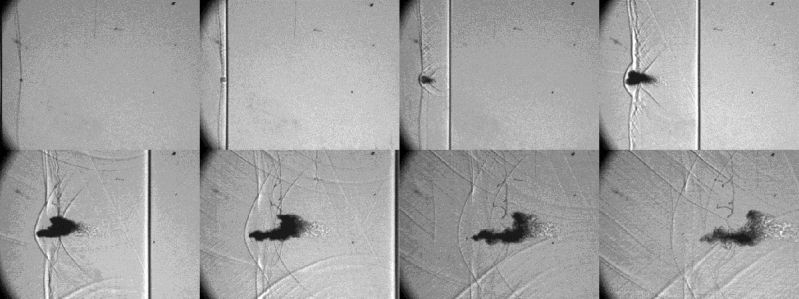Shockwave impact on a droplet

Innocuous as it may seem - who knows the potential impact of a raindrop on an aircraft at supersonic and even faster speeds? Thanks to the research of the Insitut Pprime (InstitutP) and CEA in France, we are beginning to understand more.
The experiment
To simulate a water droplet hitting the shock waves that precedes a supersonic aircraft, CEA and InstitutP used a small shock tube to hit a suspended droplet with a Mach 4 shockwave.
In order to capture the event and observe the shock/droplet interaction, the shock tube test section was designed with portals to allow schlieren imaging of the droplet shock interaction using an SI-LUX laser illuminator and the Specialised Imaging SIM camera.
A single water droplet suspended by intersecting threads, was hit by a shockwave travelling at approximately 1350 metres per second. The images shown were taken at 100,000fps, with subsequent work requiring 2Mfps. Although capable of up to 1Bfps, the SIM camera is versatile enough to be equally adept at capturing sequences at much slower rates when necessary.
Read the paper given by the authors from CEA and Institut Pprime:
Investigation of mechanisms leading to water drop breakup at Mach 4.4 and Weber numbers above 105
What does happen when it rains on a supersonic aircraft?
Thankfully nothing destructive. Before a raindrop can hit a supersonic aircraft it will be changed by shockwaves ahead of the aircraft surface. The experiment shows atomisation of water droplets, reducing the risk of damage to the aircraft. The knowledge gained from this experiment is relevant to anyone interested on the likely impact of rain, not just on supersonic aircraft, but even those travelling faster at hypersonic speeds (Mach 5) and beyond.
There are two other similar applications where the knowledge gained from this experiment could prove useful:
Firstly, fuel efficiency. In internal combustion engines fuel, typically diesel, avgas or petrol, is injected as droplets. The smaller the droplet the more complete the combustion. If shock waves could be created within the engine to atomise the fuel it could potentially create a more energy efficient engine.
Secondly, blast mitigation. To reduce the energy within shock waves created by an improvised explosive device (IED) the IED could be covered in foam, where the droplets in the foam absorb the shock energy when atomised. The foam could both cool and reduce the effect of the shockwaves from any blast, which are as potentially damaging as heat and fragmentation.
This relatively simple experiment, and the SIM camera’s ability to capture it, may well inform flight, engine and IED management innovations of the future.




























